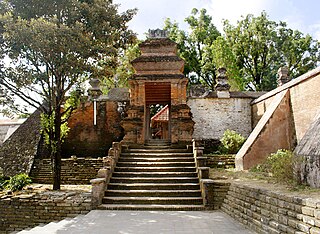
The Sultanate of Mataram was the last major independent Javanese kingdom on the island of Java before it was colonised by the Dutch. It was the dominant political force radiating from the interior of Central Java from the late 16th century until the beginning of the 18th century.
Ken Arok, Rajasa, was the founder and first ruler of Singhasari, a medieval Indianized Hindu–Buddhist kingdom in the East Java area of Indonesia. He is considered the founder of the Rajasa dynasty of the Singhasari and Majapahit line of monarchs. He came from humble origins but subsequently rose to be the most powerful ruler in Java. His life was coloured with adventures, treacheries, and tragedies.

Kotagede is a city district (kemantren) and a historic neighborhood in Yogyakarta, Special Region of Yogyakarta, Indonesia. Kotagede contains the remains of the first capital of Mataram Sultanate, established in the 16th century. Some of the remains of the old Kotagede are remains of the palace, the royal cemetery, the royal mosque, and defensive walls and moats. Kotagede is well known internationally for its silver crafting.

The Kingdom of Pajang or Sultanate of Pajang was a short-lived Muslim state in Java. It was established by Hadiwijaya or Jaka Tingkir, Lord of Boyolali, after a civil war and was a successor to Sultanate of Demak. Hadiwijaya claimed to be a descendant of Brawijaya V, the last king of the Majapahit empire, and Trenggana, the sultan of Demak.

A kyai is an expert in Islam, usually used among the ethnic Javanese people.

Amangkurat II was the susuhunan of the Sultanate of Mataram from 1677 to 1703. Before taking the throne, he was the crown prince and had the title Pangeran Adipati Anom.

The Banten Sultanate was a Bantenese Islamic trading kingdom founded in the 16th century and centred in Banten, a port city on the northwest coast of Java; the contemporary English name of both was Bantam. It is said to have been founded by Sunan Gunungjati, who had previously founded Cirebon.
Abu Nasr Abdul Kahhar was the seventh Sultan of Banten from 1682 to 1687, who was largely responsible for subjugating Banten to the Dutch East India Company (VOC). He had considerable political power as a crown prince, and from the 1650s the court was divided into factions in support of his father Ageng and him. The VOC even called them the "old Sultan" and "young Sultan," respectively. Haji's faction was in favor of a stronger relationship with the VOC in nearby Batavia, while Ageng was a firm opponent of such a relationship.

Sekaten is a week-long Javanese traditional ceremony, festival, fair and pasar malam commemorating Mawlid, celebrated annually started on 5th day through the 12th day of Mulud month.

Kyai Haji Ahmad Dahlan, often abbreviated to K.H. Ahmad Dahlan, was an Indonesian Muslim religious leader and revivalist, who established the Muhammadiyah organization. Which would become one of the largest Muslim organizations in Indonesia, second only to the Nahdlatul Ulama. Born in Kauman, Yogyakarta, he was the son of an imam of a local mosque and traced his origins from the lineage of Muhammad. Ahmad Dahlan performed the Hajj pilgrimage when he was 15 years old, and he lived in Mecca for another five years.

Grobogan Regency is a regency located in northeastern part of the Central Java province in Indonesia. Created on 4 March 1726, the Grobogan Regency has an area of 2,023.84 km2, and is the second largest regency in the Central Java Province. It had a population of 1,308,696 at the 2010 census and 1,453,526 at the 2020 census; the official estimate as at mid 2023 was 1,514,301. Its capital is the town of Purwodadi.

The Sultanate of Cirebon was an Islamic sultanate in West Java founded in the 15th century. It is said to have been founded by Sunan Gunungjati, as marked by his letter proclaiming Cirebon's independence from Pajajaran in 1482, although the settlement and the polity had been established earlier, in 1445. Sunan Gunungjati also established the Sultanate of Banten. It was one of the earliest Islamic states established in Java, along with the Sultanate of Demak.
Joko Tingkir, or sometimes written as Jaka Tingkir, is the founder and the first king of the Sultanate of Pajang. He ruled from 1549 to 1582. He is also known by the title of Sultan Hadiwijaya.

Surakarta Sunanate is a Javanese monarchy centred in the city of Surakarta, in the province of Central Java, Indonesia.
Serat Centhini is a twelve-volume compilation of Javanese tales and teachings, written in verse and published in 1814. The work was commissioned, directed, and partially written by Crown Prince Mangkunegoro, later enthroned as Pakubuwono V of Surakarta, with contributions from three court poets from different palaces.

Saka Tunggal Mosque is a mosque located in Cikakak, Banyumas, Central Java. Established in 1871, it is considered a Cultural Property of Indonesia. The complex is home to thousands of monkeys.
Panembahan Senapati, formally styled Panembahan Senapati ing Ngalaga Sayyidin Panatagama, was the founder of the Mataram Sultanate.

The Pura Mangkunegaran is a palace complex in the city of Surakarta, Central Java, Indonesia. It is the official palace and residence of the Duke of Mangkunegara and his family. The palace complex is one of the centers of Javanese culture and contains a museum exhibiting royal artifacts of Mangkunegaran.
Ki Ageng Ngenis was an Indonesian preacher who played a role in preaching Islam in Surakarta. He was the father of Ki Ageng Pamanahan and the grandfather of Senapati of Mataram.












